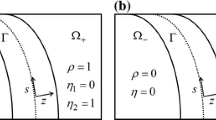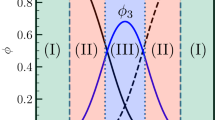Abstract
In order to address the growth of crystals in veins, a multiphase-field model is used to capture the dynamics of crystals precipitating from a super-saturated solution. To gain a detailed understanding of the polycrystal growth phenomena in veins, we investigate the influence of various boundary conditions on crystal growth. In particular, we analyze the formation of vein microstructures resulting from the free growth of crystals as well as crack-sealing processes. We define the crystal symmetry by considering the anisotropy in surface energy to simulate crystals with flat facets and sharp corners. The resulting growth competition of crystals with different orientations is studied to deduce a consistent orientation selection rule in the free-growth regime. Using crack-sealing simulations, we correlate the grain boundary tracking behavior depending on the relative rate of crack opening, opening trajectory, initial grain size, and wall roughness. Further, we illustrate how these parameters induce the microstructural transition between blocky (crystals growing anisotropically) to fibrous morphology (isotropic) and formation of grain boundaries. The phase-field simulations of crystals in the free-growth regime (in 2D and 3D) indicate that the growth or consumption of a crystal is dependent on the orientation difference with neighboring crystals. The crack-sealing simulation results (in 2D and 3D) reveal that crystals grow isotropically and grain boundaries track the opening trajectory if the wall roughness is high, opening increments are small, and crystals touch the wall before the next crack increment starts. Further, we find that within the complete crack-seal regime, anisotropy in surface energy results in the formation of curved/oscillating grain boundaries (instead of straight) when the crack-opening velocity is increased and wall roughness is not sufficiently high. Additionally, the overall capability of phase-field method to simulate large-scale polycrystal growth in veins (in 3D) is demonstrated enumerating the main advantages of adopting the novel approach.










Similar content being viewed by others
References
Barker SL, Cox SF, Eggins SM, Gagan MK (2006) Microchemical evidence for episodic growth of antitaxial veins during fracture-controlled fluid flow. Earth Planet Sc Lett 250(1–2):331 – 344
Bhat HL, Ristić RI, Sherwood JN, Shripathi T (1992) Dislocation characterization in crystals of potash alum grown by seeded solution growth under conditions of low supersaturation. J Cryst Growth 121(4):709 – 716
Bons AJ, Bons PD (2003) The development of oblique preferred orientations in zeolite films and membranes. Micropor Mesopor Mat 62(1–2):9 – 16
Bons PD (2001) Development of crystal morphology during unitaxial growth in a progressively widening vein: I. the numerical model. J Struct Geol 23(6–7):865 – 872
Bons PD, Jessell MW (1997) Experimental simulation of the formation of fibrous veins by localised dissolution-precipitation creep. Mineral Mag 61(1):53–63
Chen L-Q (2002) Phase-field models for microstructure evolution. Ann Rev Mater Res 32(1):113–140
Cox SF, Etheridge MA (1983) Crack-seal fibre growth mechanisms and their significance in the development of oriented layer silicate microstructures. Tectonophysics 92(1–3):147 – 170
Cox SF, Etheridge MA, Wall VJ (1987) The role of fluids in syntectonic mass transport, and the localization of metamorphic vein-type ore deposists. Ore Geol Rev 2(1-3):65–86
Durney D (1972) Solution-transfer, an important geological deformation mechanism. Nature 235(5337):315–317
Durney DW, Ramsay JG (1973) Incremental strains measured by syntectonic crystal growths. In: De Jong KA, Scholten K (eds) Gravity and tectonics. Wiley, New York, pp 67–96
Durney DW (1976) Pressure-solution and crystallization deformation. Phil Trans R Soc A 283(1312):229–240
Fisher DM, Brantley SL (1992) Models of quartz overgrowth and vein formation: deformation and episodic fluid flow in an ancient subduction zone. J Geophys Res 97(B13):20043–20061
Hilgers C, Urai JL (2002a) Experimental study of syntaxial vein growth during lateral fluid flow in transmitted light: first results. J Struct Geol 24(6–7):1029–1043
Hilgers C, Urai JL (2002b) Microstructural observations on natural syntectonic fibrous veins: implications for the growth process. Tectonophysics 352(3–4):257–274
Hilgers C, Koehn D, Bons PD, Urai JL (2001) Development of crystal morphology during unitaxial growth in a progressively widening vein: II. Numerical simulations of the evolution of antitaxial fibrous veins. J Struct Geol 23(6–7):873 – 885
Kim SG, Kim DI, Kim WT, Park YB (2006) Computer simulations of two-dimensional and three-dimensional ideal grain growth. Phys Rev E 74:061,605
Klapper H, Becker RA, Schmiemann D, Faber A (2002) Growth-sector boundaries and growth-rate dispersion in potassium alum crystals. Cryst Res Technol 37(7):747–757
Knipe RJ, McCaig AM (1994) Microstructural and micromechanical consequences of fluid flow in deforming rocks. In: Parnell J (ed) Geofluids: origin, migration and evolution of fluids in sedimentary basins, vol 78. Geological Society, London, Special Publication, pp 99–111
Koehn D, Hilgers C, Bons PD, Passchier CW (2000) Numerical simulation of fibre growth in antitaxial strain fringes. J Struct Geol 22(9):1311–1324
McCaig AM (1988) Deep fluid circulation in fault zones. Geology 16(10):867–870
Mügge O (1925) Über gehemmtes kristallwachstum. Z Kristallogr 62(5/6):415–442
Mullin JW (2001) Crystallization. Butterworth-Heinemann, Oxford
Nestler B, Choudhury A (2011) Phase-field modeling of multi-component systems. Curr Opin Solid State Mater Sci 15(3):93 – 105
Nestler B, Garcke H, Stinner B (2005) Multicomponent alloy solidification: phase-field modeling and simulations. Phys Rev E 71:041,609
Nestler B, Reichardt M, Selzer M (2008) Massive multi-phase-field simulations: methods to compute large grain system. In: Hirsch J, Skrotzki B, Gottstein G (eds) Proceedings of the 11th international conference on aluminium alloys. Aachen, Germany, pp 1251–1255
Nollet S, Urai JL, Bons PD, Hilgers C (2005) Numerical simulations of polycrystal growth in veins. J Struct Geol 27(2):217–230
Nollet S, Hilgers C, Urai JL (2006) Experimental study of polycrystal growth from an advecting supersaturated fluid in a model fracture. Geofluids 6(2):185–200
Ramsay JG (1980) The crack-seal mechanism of rock deformation. Nature 284(5752):135–139
Ramsay JG, Huber MI (1983) Techniques in modern structural geology. Strain analysis, vol 1. Academic Press, London
Schmidegg O (1928) Über geregeltes wachstumsgefüge. Jb Geol Bundesanstalt 78:1–51
Sekerka RF (2005) Equilibrium and growth shapes of crystals: how do they differ and why should we care? Cryst Res Technol 40(4-5):291–306
Singer-Loginova I, Singer H (2008) The phase field technique for modeling multiphase materials. Rep Progr Phys 71(10):106501
Stinner B, Nestler B, Garcke H (2004) A diffuse interface model for alloys with multiple components and phases. SIAM J Appl Math 64(3):775–799
Thijssen JM, Knops HJF, Dammers AJ (1992) Dynamic scaling in polycrystalline growth. Phys Rev B 45:8650–8656
Thornton K, Ågren J, Voorhees P (2003) Modelling the evolution of phase boundaries in solids at the meso- and nano-scales. Acta Mater 51(19):5675 – 5710
Urai JL, Williams PF, van Roermund HLM (1991) Kinematics of crystal growth in syntectonic fibrous veins. J Struct Geol 13(7):823 – 836
Williams PF, Urai JL (1989) Curved vein fibres: an alternative explanation. Tectonophysics 158(1–4):311–333
Yardley BWD, Jamtveit B (1997) Fluid flow and transport in rocks : mechanisms and effects. Chapman & Hall, London
Zhang J, Adams JB (2002) Facet: a novel model of simulation and visualization of polycrystalline thin film growth. Model Sinul Mater Sc 10(4):381
Acknowledgments
Drs. Abhik Choudhury (Ecole Polytechnique, Palaiseau, France) and Frank Wendler (Institute of Applied Geosciences, Karlsruhe Institute of Technology) are thanked for many insightful discussions. KA and BN acknowledge the financial support by Graduate school 1483 of German Research Foundation and by the project CCMSE of the European Union (EFRE) together with the state Baden-Wuerttemberg. KA also thanks former co-workers Drs. Denis Pilipenko and Michael Fleck (Materials and Process Simulations, University of Bayreuth) for preliminary discussions concerning the model and Center for Computing and Communication at RWTH Aachen University (HPC Cluster) for computational resources.
Author information
Authors and Affiliations
Corresponding author
Additional information
Communicated by M. W. Schmidt.
Rights and permissions
About this article
Cite this article
Ankit, K., Nestler, B., Selzer, M. et al. Phase-field study of grain boundary tracking behavior in crack-seal microstructures. Contrib Mineral Petrol 166, 1709–1723 (2013). https://doi.org/10.1007/s00410-013-0950-x
Received:
Accepted:
Published:
Issue Date:
DOI: https://doi.org/10.1007/s00410-013-0950-x




